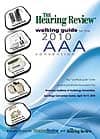It is secreted inside the external auditory canal. It can become so insidious as to cause hearing loss, or it can ooze out of the ear into the cracks and crevices of hearing instruments, clogging ports and damaging the receiver. “It” is not an uncontainable virus, bacteria, or ear monster, but cerumen, more commonly known as earwax, and thankfully, properly trained hearing professionals can control it.
For some, cerumen management may be as simple as the swipe of a morning Q-tip inside the outer ear. For individuals who have a hearing impairment, however, proper cerumen hygiene is essential for the health of the hearing instrument—and the wearer.
THE PURPOSE OF CERUMEN
Cerumen is a substance found in the external auditory canal and is made from a mixture of secretions from the sebaceous glands and the ceruminous glands. Cerumen can be dry and flaky, but is most commonly seen in a pasty liquid form that has oily, fatty, and acidic characteristics.
|
For more about hearing aid repairs and maintenance, see “Under Repair” from the March/April issue. |
Cerumen performs an important function in the body’s natural ear maintenance system, moisturizing and protecting the skin of the external ear canal, as well as trapping dust and particles before they reach the tympanic membrane. Talking, chewing, and other mandible actions help to move wax debris to the external ear where it can be safely swabbed.
When cerumen does not properly work itself out of the ear canal, it can build up and harden, adhering to the inner ear canal wall and forming a partial or total plug over the tympanic membrane, resulting in a hearing loss.
For individuals who wear ITE hearing aids or even earmolds for BTE models, cerumen excretions can clog ports and cause damage to the receiver, as well as cause a variety of other problems that can produce instrument feedback and diminish the performance of the hearing aid.
DIAGNOSING EXCESSIVE CERUMEN
Because cerumen production can be excessive in humans who wear hearing instruments, it is important for patients to have themselves and their hearing instruments checked regularly for a disproportionate amount.
Cerumen buildup accounts for the majority of hearing aid repairs, many of which could be avoided if proper maintenance and precautions were implemented. “Earwax is a very important part of repair,” says Dick Kaiser, president of Mobile, Ala-based Discovery Hearing Aid Repair (Co-Op Inc). “Earwax can infiltrate into the hearing aid and cause some significant damage or significant harm to the components that have to be repaired or replaced. So, microphone and receiver replacement is a common issue, as well as wiring.”
ITE hearing aids, for instance, are prone to receiver failure due to cerumen accumulating in the sound outlet port. When the hearing aid is inserted into the ear, it can inadvertently scrape wax deposits from the ear into the sound port. Wax guards and wax springs can help to some degree, but if the cerumen accumulates in these ports over time, the hearing aid can eventually become damaged and need to be repaired by a professional technician.
The ear’s cerumen troubles are generally diagnosed by an audiologist, physician, or properly trained dispenser with an otoscopic exam. The otoscopic exam should immediately reveal whether the patient has a cerumen plug or a significant amount of cerumen that needs to be removed. It should also reveal any perforations in the tympanic membrane, an area which may exclude the use of irrigation to remove the cerumen.
Proper illumination is important for any inspection of the ear canal. Aside from an otoscope, a headlamp with magnification may also be used. In addition, there is now the video otoscope, a small camera inserted into the ear canal that displays the image on a monitor. Video otoscopes may be helpful for both diagnosis and cerumen removal techniques.
MANAGING CERUMEN

|
| A.U. Bankaitis, PhD, FAAA |
There are three cerumen removal techniques that can be used by audiologists:
- Mechanical removal, which incorporates removal of cerumen from the external auditory canal using several common hand-held instruments;
- The irrigation technique, which employs a cerumen-softening agent and a rubber irrigation syringe to soften the cerumen and gently flush the canal of debris; and
- The suction technique, which uses a specially designed aspiration device that is sometimes combined with an irrigation component.
Hearing health professionals can use a combination of these three techniques, or use each independently. The technique is typically left up to the preference and the discretion of the professional involved in removing the cerumen.
A.U. Bankaitis, PhD, FAAA, is an audiologist who conducts cerumen removal training for hearing professionals and is the vice president and general manager of Oaktree Products Inc, St Louis, which sells instruments for cerumen management as well as other tools and products for the hearing health industry.
TOOLS OF THE TRADE

|
| One technique for earwax removal, as shown in the Illustrated Guide to Cerumen Management, a CD edited by Sam Kelso, AuD. |
Bankaitis prefers the mechanical technique because it is simple and relatively inexpensive, and because patients generally enjoy the sensation of mechanical cerumen removal, which is similar to that of cleaning the ear canal with a Q-tip. With the mechanical technique, cerumen that has a moist and pasty consistency is removed with a variety of handheld instruments, including curettes, loops, and hooks. Each instrument has a thin handle with a tip that is angled at varying degrees. Available in different shapes and sizes, from an elliptical loop to a small “o,” all cerumen tools work effectively to remove cerumen plugs, Bankaitis says. The design chosen is a matter of personal preference and according to the cerumen’s consistency.
Whichever instrument is selected, the user inserts it into the auditory canal and positions the tip as far behind the cerumen plug as possible, then gently pulls out the plug.
A specially designed tool known as alligator forceps may also be used when the cerumen has a drier consistency. With a long stem tipped by small pincers at the end, this forceps can grab and extricate dry bits of cerumen. However, sometimes cerumen can be so dry and adhesive that removing it with curettes or forceps can tear the lining of the auditory canal and cause bleeding. In these cases Bankaitis recommends using cerumen softening agents.
SOFTENING AGENTS AND IRRIGATION
Softening agents can be made from chemical-based formulas, as well as natural products made from various natural oils, vitamin extracts, and botanical derivatives. Generally, a few drops of the softening agent are introduced into the ear canal. Then, several hours—or in some extreme cases, several days—later, a rubber syringe filled with warm water may be used to flush the cerumen out of the ear canal. Mechanical instruments may also be used.
Both types of softening formulas are generally considered to be effective, but, concerned about potential harmful effects of chemical-based mixtures ear canal’s delicate layer of skin, Marilyn Harris, CEO of MiraCell Inc, Orem, Utah, has developed the all-natural MiraCell, which she says not only softens cerumen attached to the ear canal’s wall, but also can help the skin to renew itself after the cerumen is removed.
Although softening agents are considered safe for consumers when used as directed, Robert Davis, president of Nurturell Inc, Pueblo, Colo, still recommends that patients consult with hearing health care professionals before application. The professional will visually verify the integrity of the tympanic membrane and make sure there are no perforations. If a patient has a perforated eardrum, there is an increased risk of water and infection entering the middle ear.
In addition, a professional will be trained in the proper use of the rubber syringe. Flushing the auditory canal too forcefully can seriously damage the tympanic membrane.
Regular application of some softening agents may also help prevent excessive buildup of cerumen and help the cerumen stay more liquid, exiting the canal naturally and moving out into the external ear.
Finally, there are specially designed suction devices that can effectively clear the external auditory canal. These may be used with or without softening agents, depending on the device and the preference and experience of the hearing health professional.
PRECAUTIONS FOR CERUMEN MANAGEMENT
It is difficult to imagine a person being harmed by managing cerumen, yet because of the delicate nature of the auditory canal, improper use of a mechanical tool, suction, or irrigation technique may cause injury not only to the ear canal, but also to the patient’s overall health.
As mentioned previously, it is important for the patient’s eardrum to be free of any perforation before using irrigation. In addition, irrigation is contraindicated for patients with diabetes because of otitis externa, an infection of the auditory ear canal that is seen commonly in diabetics.
Bankaitis explains, “Otitis externa is mainly caused by a bacteria called Pseudomonas aeruginosa. Diabetic patients have consistently exhibited more alkaline, or elevated, pH levels at the level of the external auditory canal. When you start introducing irrigation into the external auditory canal, it can actually exacerbate otitis externa.” Eventually, the infection can spread to the temple bone and lead to a severe infection throughout the entire body.
Naturally, professionals need to be cautious when inserting instruments into the ear as well, making sure that there is sufficient light and visibility. And though it may feel great to patients, inserting a Q-tip into the auditory canal to remove cerumen can risk puncturing the tympanic membrane as well as irritation of the canal wall.
As for the future of cerumen management, Bankaitis says, “I don’t think you’ll see any new techniques, but what I hope you’ll see is that more students are taught how to remove cerumen, so that when they go into private practice or have their first jobs as audiologists, they’re in a position to remove the cerumen and can do a good job. That’s what I hope to see in the future.”
Similarly, Davis believes that cerumen management is overlooked by both patients and hearing professionals. He says, “We’re selling such high-priced hearing aids today, and we’re really not addressing cerumen management. There are so many professionals out there who don’t address it, and I really believe that it’s the wave of the future. Too many people are ruining their hearing aids with wax. Management of the wax will make the manufacturers happy, the patients happy, and the audiologists and dispensers happy because it cuts down on time. When patients are happy and don’t have to send their hearing aids in for repair, it’s a win-win situation.”
Tor Valenza is staff writer for Hearing Products Report. He can be reached at [email protected]





